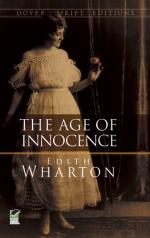She made way for him by pushing back her chair, and promptly, and a little ostentatiously, with the desire that the whole house should see what he was doing, Archer seated himself at the Countess Olenska’s side.
“We did use to play together, didn’t we?” she asked, turning her grave eyes to his. “You were a horrid boy, and kissed me once behind a door; but it was your cousin Vandie Newland, who never looked at me, that I was in love with.” Her glance swept the horse-shoe curve of boxes. “Ah, how this brings it all back to me—I see everybody here in knickerbockers and pantalettes,” she said, with her trailing slightly foreign accent, her eyes returning to his face.
Agreeable as their expression was, the young man was shocked that they should reflect so unseemly a picture of the august tribunal before which, at that very moment, her case was being tried. Nothing could be in worse taste than misplaced flippancy; and he answered somewhat stiffly: “Yes, you have been away a very long time.”
“Oh, centuries and centuries; so long,” she said, “that I’m sure I’m dead and buried, and this dear old place is heaven;” which, for reasons he could not define, struck Newland Archer as an even more disrespectful way of describing New York society.
III.
It invariably happened in the same way.
Mrs. Julius Beaufort, on the night of her annual ball, never failed to appear at the Opera; indeed, she always gave her ball on an Opera night in order to emphasise her complete superiority to household cares, and her possession of a staff of servants competent to organise every detail of the entertainment in her absence.
The Beauforts’ house was one of the few in New York that possessed a ball-room (it antedated even Mrs. Manson Mingott’s and the Headly Chiverses’); and at a time when it was beginning to be thought “provincial” to put a “crash” over the drawing-room floor and move the furniture upstairs, the possession of a ball-room that was used for no other purpose, and left for three-hundred-and-sixty-four days of the year to shuttered darkness, with its gilt chairs stacked in a corner and its chandelier in a bag; this undoubted superiority was felt to compensate for whatever was regrettable in the Beaufort past.
Mrs. Archer, who was fond of coining her social philosophy into axioms, had once said: “We all have our pet common people—” and though the phrase was a daring one, its truth was secretly admitted in many an exclusive bosom. But the Beauforts were not exactly common; some people said they were even worse. Mrs. Beaufort belonged indeed to one of America’s most honoured families; she had been the lovely Regina Dallas (of the South Carolina branch), a penniless beauty introduced to New York society by her cousin, the imprudent Medora Manson, who was always doing the wrong thing from the right motive. When one was related to the Mansons and the Rushworths one had a “droit de cite” (as Mr. Sillerton Jackson, who had frequented the Tuileries, called it) in New York society; but did one not forfeit it in marrying Julius Beaufort?




